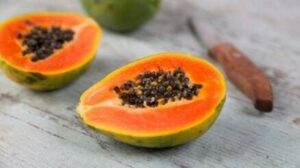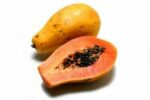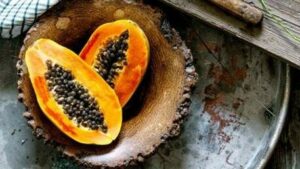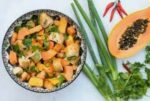Papaya (also known as papaw or pawpaw)
Papaya, the fruit of the Carica papaya plant, originated in Southern Mexico and Central America but is now grown in many other parts of the world. According to the Food and Agriculture Organization of the United Nations, in 2013, India produced over 5 million tons, making it the  world’s largest producer.
world’s largest producer.
The papaya is a soft and fleshy fruit with a shape similar to that of a pear. Its skin is green when unripe and orange once ripe. The flesh of the ripe papaya is yellow, orange or red. Known for its sweet taste and vibrant color, this fruit is full of nutrients and boasts a wide variety of health benefits.
A small papaya (about 152 grams) is rich in vitamin C (157% of RDI) vitamin A (33% of RDI), folate/B9 (14% of RDI), potassium (11% of RDI) and antioxidants known as carotenoids — particularly one type called lycopene. Research shows that the human body absorbs these antioxidants better from papayas than other fruit or vegetable.
Papaya is a good source of lutein, zeaxanthin, vitamin C, and vitamin E, — nutrients which play a protective role in eye health and the prevention of age-related macular degeneration. Lutein and zeaxanthin can protect our eyes from harmful high-energy light waves like ultraviolet rays in sunlight. Research suggests high levels of lutein and zeaxanthin in the eye tissue is linked to better vision, especially in dim light or where glare is a problem.
Beta-carotene and other red, orange and yellow pigments found in produce such papaya, apricots, broccoli, cantaloupe, pumpkin, and carrots, are called carotenoids and considered antioxidants. Our bodies convert beta-carotene to vitamin A. Consuming foods rich in beta-carotene lowers the risk of developing asthma.
Reports also suggest that beta-carotene may play a protective role against prostate cancer. Papaya is also a good source of Lycopene (a carotenoid) which has anti-cancer properties.
 In a study of 14 fruits and vegetables with known antioxidant properties, papaya was the only one to show anticancer activity in breast cancer cells.
In a study of 14 fruits and vegetables with known antioxidant properties, papaya was the only one to show anticancer activity in breast cancer cells.
Papaya is high in vitamin C and lycopene, components which may improve heart health and reduce the risk of heart disease. Antioxidants found in this fruit are thought to protect the heart and increase the protective effects of HDL cholesterol, referred to as the “good” cholesterol. With its fiber, potassium and vitamin content, papaya can be helpful in warding off heart disease. Decreasing sodium intake and increasing potassium intake is the most important dietary change one can make to reduce the risk of cardiovascular disease.
Chronic inflammation is a major contributing factor of many diseases. Studies have shown that consuming antioxidant-rich foods such as papaya help reduce inflammatory markers. According to one study, men who increased their intake of foods rich in carotenoid had a significant reduction in CRP (C-reactive protein), a protein made by the liver.
Papaya contains papain, an enzyme which can make protein easier to digest. Due to its ability to break down the tough protein chains found in muscle meat, papaya has been used to tenderize meat for thousands of years.
Vitamin C and lycopene found in papaya can help our skin look more toned and youthful. These compounds protect our skin and may help reduce wrinkling, sagging and other skin damage that happens with age.
Papaya has many black edible seeds. They are crunchy in texture, have a slightly peppery flavor and are considered by many to be perfect seasoning for a variety of dishes. Simply scoop out the seeds, rinse them well in cold water and strain them. Rub them to remove any residue and let them air-dry on a towel or baking sheet. They can be crushed or ground before adding them to your  recipe.
recipe.
This tropical fruit is delicious, nutritious and very versatile. It can be enjoyed on its own or added to many recipes. A few suggestions:
Breakfast: Cut it in half and fill each half with Greek yogurt, then top with a few blueberries and chopped nuts.
Appetizer: Cut papaya into strips and wrap a slice of ham or prosciutto around each one.
Salsa: Chop papaya, tomatoes, onions, and cilantro, then add lime juice and mix well.
Smoothie: Combine the diced fruit with coconut milk and ice in a blender, blend until smooth.
 Salad: Chop papaya and avocado into cubes, add diced cooked chicken and dress with olive oil and vinegar.
Salad: Chop papaya and avocado into cubes, add diced cooked chicken and dress with olive oil and vinegar.
Dessert: Combine the chopped fruit with 2 Tbsp. (28 grams) chia seeds, 1 c. (240 ml) almond milk, and ¼ tsp. vanilla. Mix well and refrigerate before eating.
RISKS!
People with a latex allergy may also be allergic to papaya because papayas contain enzymes called chitanases, which can cause a cross-reaction between latex and the foods that contain them.

Leave a Reply